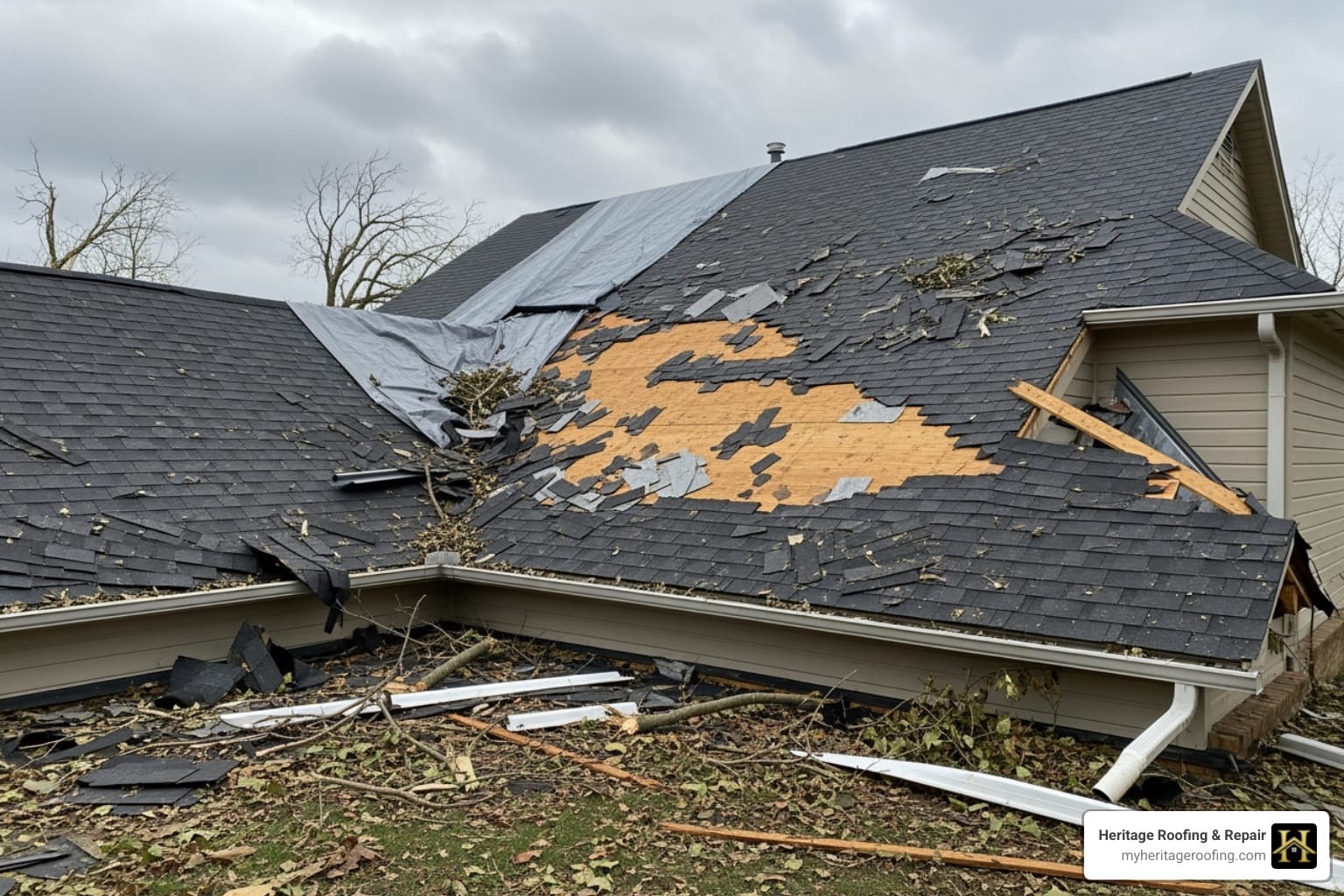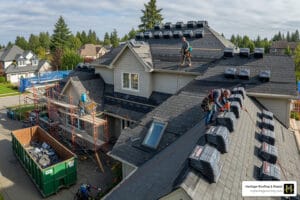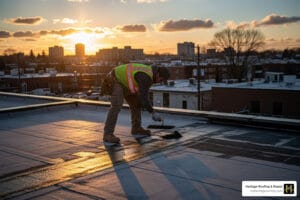Why Understanding Roof Insurance Claims Can Save You Thousands
A roof insurance claim doesn’t have to be overwhelming. When severe weather hits Northwest Arkansas, your roof often bears the brunt of the damage. Home insurance companies pay an average of $13,000 for wind and hail claims, but many homeowners leave money on the table because they don’t understand the process. Knowing what to expect and when to seek expert roofing services can make all the difference. The path from damage to repair is manageable with the right knowledge.
Key Steps for Filing a Roof Insurance Claim:
- Assess damage safely from the ground.
- Document everything with photos and notes.
- Review your policy to understand coverage and deductibles.
- Contact your insurer promptly to meet filing deadlines.
- Get a professional inspection before the adjuster’s visit.
- Be present when the adjuster inspects the property.
What’s Typically Covered: Wind damage, hail damage, fallen trees, fire, and other sudden accidents.
What’s Usually NOT Covered: Normal wear and tear, poor maintenance, gradual leaks, and cosmetic damage.
For homeowners dealing with storm damage roof repair, understanding the claims process is as important as fixing the damage. Filing too late, providing inadequate documentation, or not understanding your policy’s terms can cost you thousands in out-of-pocket expenses. At Heritage Roofing & Repair, we’ve guided countless homeowners in Berryville and Northwest Arkansas through the insurance process for over 50 years, working directly with adjusters to ensure a fair settlement.

Before You File: Understanding Your Homeowner’s Policy
Before calling your insurance agent, your most powerful tool is your policy document. Understanding its coverage, limitations, and key terms will set you up for a smoother claims process. Reviewing your policy annually is a critical part of homeownership.
Covered vs. Uncovered Damage: What Your Policy Includes
Generally, home insurance policies cover damage that is “sudden and accidental.” If a tree falls on your roof during a storm or hail pummels your shingles, you are likely covered. These events are called “perils.”
Commonly covered perils include:
- Wind Damage: Strong winds can lift shingles, detach flashing, or tear off sections of your roof. Wind and hail claims average $13,000.
- Hail Damage: Hail can bruise or crack shingles and dent vents, compromising your roof’s integrity.
- Fallen Trees or Branches: Trees crashing onto your roof due to wind, ice, or decay are typically covered.
- Fire and Smoke: Damage from a fire is usually a covered peril.
- Weight of Snow, Ice, or Sleet: Heavy accumulation can cause structural damage or leaks.
It’s equally important to know what’s not covered. Most policies exclude damage from:
- Normal Wear and Tear: An aging roof with curled or brittle shingles is a maintenance issue, not a sudden accident.
- Lack of Maintenance: If neglected gutters or ignored minor repairs lead to significant damage, your claim could be denied.
- Pre-existing Damage: Insurers will not cover damage that existed before the storm or event you are claiming.
- Gradual Leaks: A slow leak that develops over time is often not covered.
- Cosmetic Damage: Some policies have exclusions for cosmetic issues, like hail dents that don’t affect the roof’s function.
For more details, resources like the Texas Department of Insurance offer guidance on what to know when filing claims. If your roof needs immediate attention to prevent further issues, temporary emergency repairs are crucial.
Replacement Cost Value (RCV) vs. Actual Cash Value (ACV): A Critical Difference
This distinction directly impacts how much money you’ll receive for your roof. It’s one of the most important parts of your policy.
- Replacement Cost Value (RCV): An RCV policy pays the cost to replace your damaged roof with new, similar materials, without deducting for depreciation. If a new roof costs $15,000, an RCV policy pays that full amount (minus your deductible).
- Actual Cash Value (ACV): An ACV policy pays the current value of your roof, factoring in depreciation for its age and condition. If your 15-year-old roof (with a 30-year lifespan) is destroyed, it’s 50% depreciated. On a $15,000 replacement, an ACV policy might only pay $7,500 (minus your deductible), leaving you with a large gap to cover.
Here’s a simple comparison:
| Feature | Replacement Cost Value (RCV) | Actual Cash Value (ACV) |
|---|---|---|
| Payout Basis | Cost to replace with new, similar materials | Depreciated value of the damaged roof (age, condition) |
| Depreciation | Not deducted | Deducted from replacement cost |
| Out-of-Pocket | Typically lower (only deductible) | Potentially much higher (deductible + depreciation) |
| Premium | Generally higher | Generally lower |
We always recommend an RCV policy if possible for greater peace of mind.
Understanding Your Deductible and How It Affects Your Payout
Your deductible is the amount you pay out-of-pocket before your insurance coverage begins. Deductibles can be a fixed dollar amount (e.g., $1,000) or a percentage of your home’s insured value (e.g., 1% of a $200,000 home is a $2,000 deductible).
The insurer subtracts your deductible from the approved claim amount. If the repair cost is only slightly more than your deductible, it may be better to pay out-of-pocket to avoid a potential premium increase. For more information, GAF offers a helpful Understanding Your Insurance Policy video series.
The Step-by-Step Guide to Your Roof Insurance Claim
Filing a claim is straightforward when broken into manageable steps. Acting promptly and staying organized are key. The process can take a few weeks to a couple of months, with an approval or denial decision often coming within 10 days of the adjuster’s inspection.
Step 1: Assess and Document the Damage (Safely!)
After a storm, your first priority is safety. Do not climb on a damaged roof. Instead, conduct a thorough ground-level inspection, using binoculars if necessary. Look for:
- Missing, curled, or damaged shingles
- Dented gutters, downspouts, or roof vents
- Asphalt granules in your downspouts
- Interior water stains on ceilings or walls
- Debris on the roof, like large branches
Next, document everything. This is a critical step for a successful roof insurance claim.
- Photos: Take clear, date-stamped photos of all damage from multiple angles.
- Video: A narrated video walk-through can provide a comprehensive overview.
- Notes: Keep a log of the damage, the date you noticed it, and any temporary repairs made (keep receipts!).
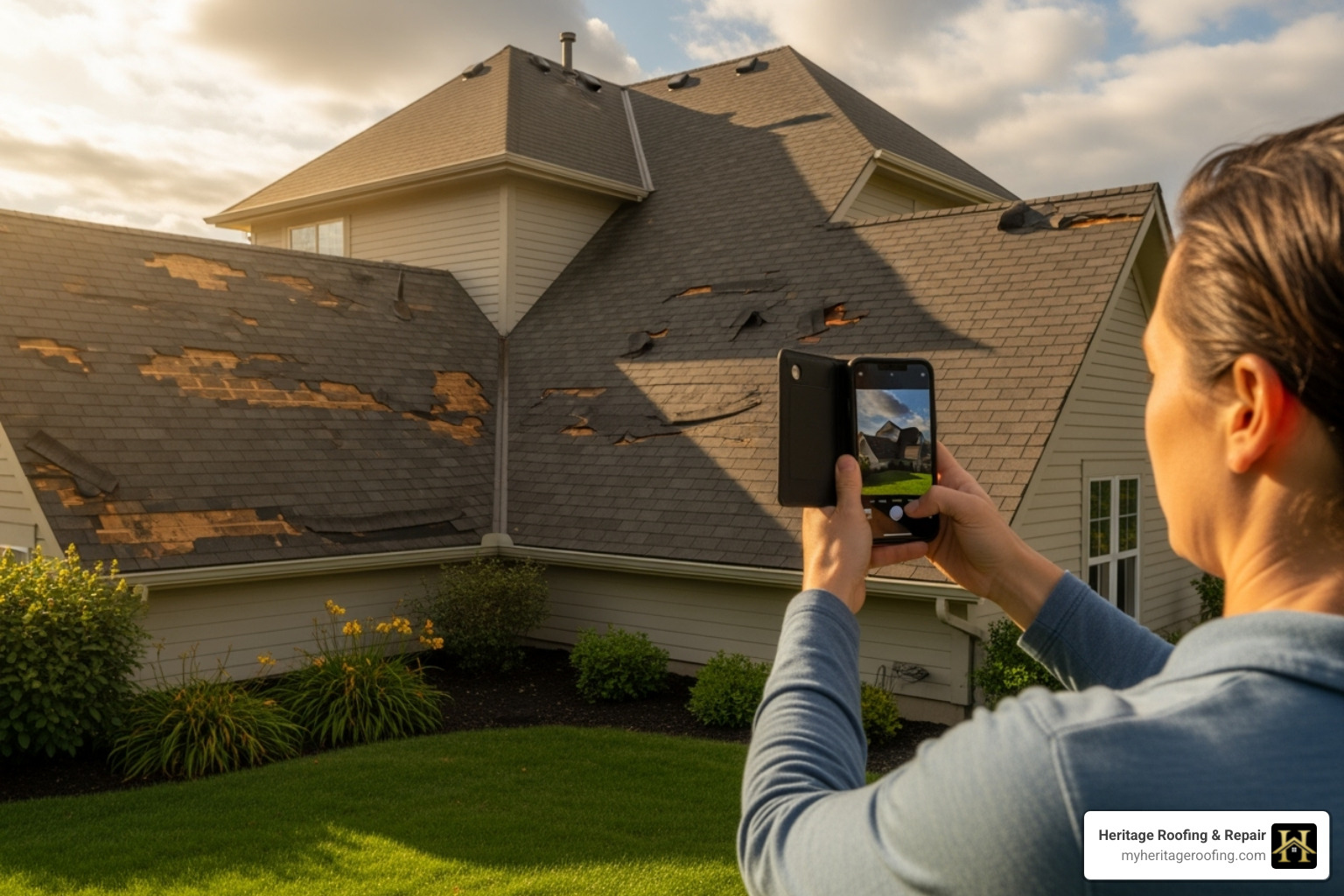
Step 2: When to File and What Documentation is Needed
File your claim as quickly as possible after noticing damage. Most insurers have a limited timeframe for filing, and delaying can lead to further damage and potential denial. To file, you should prepare:
- A summary of the roof damage
- Your photos and videos
- The age of your existing roof
- The date of the storm or incident
- A detailed estimate from a certified roofing company
- Maintenance records to counter any claims of neglect
Having this information ready will significantly speed up your claim.
Step 3: Contacting Your Insurer and Meeting the Adjuster
With your documentation in hand, contact your insurance company to initiate the claim. You will be assigned a claim number and an insurance adjuster.
It is critical to be present during the adjuster’s inspection. This allows you to point out all areas of concern and provide your documentation. We also highly recommend having your chosen roofing contractor present. An expert can speak the adjuster’s language and ensure all damage is identified, which is especially helpful for complex issues like storm damage roof repair.
If you want a contractor advocate on-site during your inspection, you can reach Heritage Roofing & Repair at (870) 654-1164.
The Professional’s Role: How a Roofer Can Help Your Claim
You don’t have to steer the insurance process alone. A qualified, local roofing contractor is an invaluable partner, acting as your advocate to ensure all damage is accurately identified and the repair scope is fair.
Why a Professional Roof Inspection is Your First Best Move
Before calling your insurer, a professional roof inspection is your best first move. A skilled roofer can identify damage you might miss, especially subtle issues that still compromise your roof’s integrity.
- Expert Damage Identification: Professionals spot hidden damage like hail bruising or wind-lifted flashing that an untrained eye would miss.
- Detailed Reporting: A reputable contractor provides a comprehensive report with photos and a detailed scope of work, which is powerful documentation for your claim.
- Accurate Estimates: A professional estimate ensures the scope of work presented to your insurer is fair and complete, preventing you from being underpaid.
- Increased Approval Rates: Professional inspections can significantly increase claim approval rates. Roofers know what adjusters look for and can present the damage in a way that aligns with insurance criteria, especially for hail and wind damage.
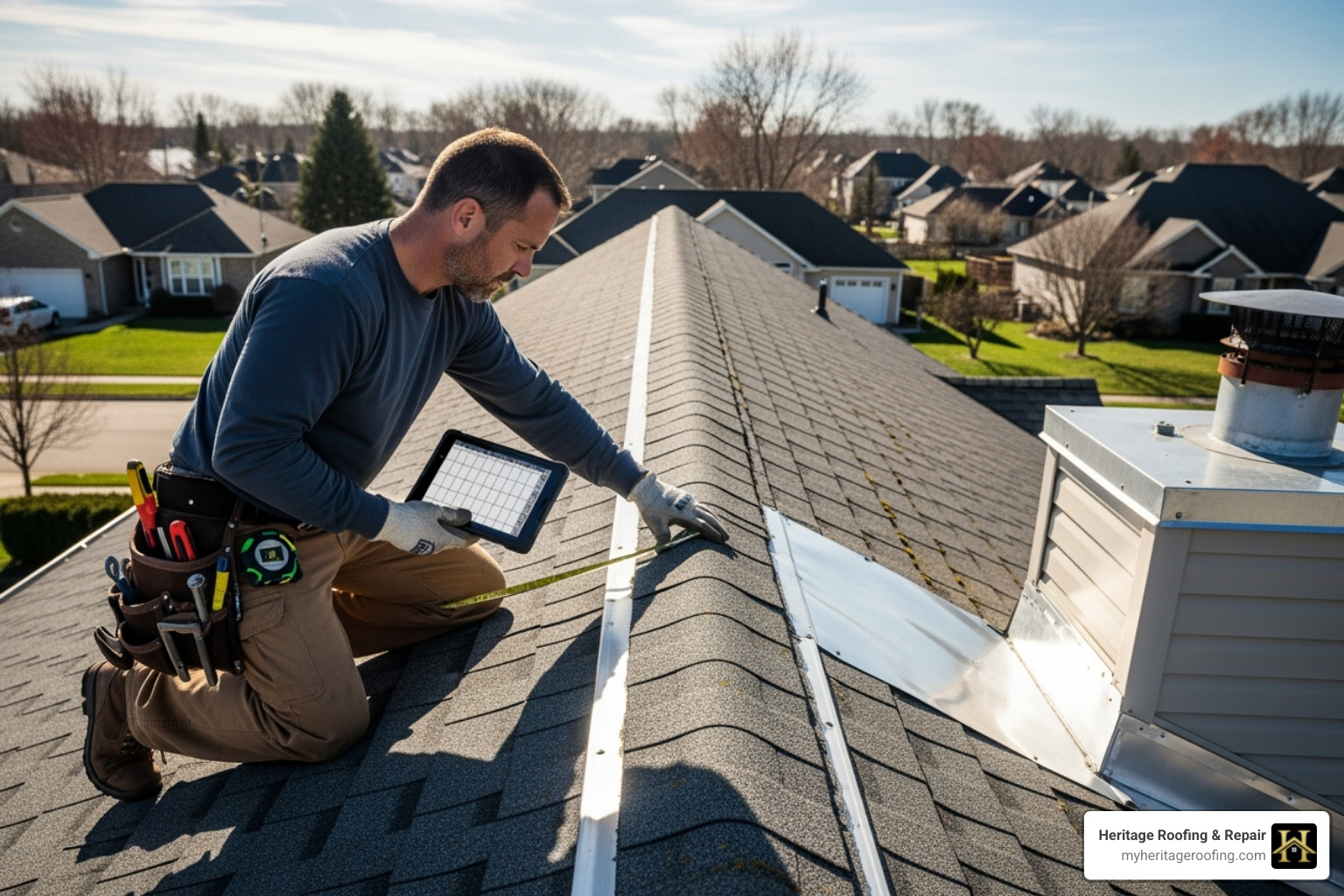
Finding a Trusted Local Roofing Expert in Northwest Arkansas
When you need an expert eye on your roof, call a local professional with a deep understanding of Arkansas weather and building codes. For homeowners in Berryville, Fayetteville, Harrison, and throughout Northwest Arkansas, our team at Heritage Roofing & Repair is ready to help. With over 50 years of experience, we specialize in storm damage and insurance claims.
You can find us at:
Heritage Roofing & Repair
3458 Arkansas State Hwy 221, Berryville, AR 72616
Common Pitfalls: How to Avoid Claim Denial and Premium Hikes
A denied claim is frustrating, but many denials are avoidable. Understanding why insurers deny claims can help you prepare a stronger case. It’s also wise to consider how a claim might affect your future insurance costs.
Top Reasons for Claim Denial (And How to Prevent Them)
Here are the most common reasons a roof insurance claim is denied and how to prevent them:
- Lack of Maintenance: Insurers often deny claims for damage they deem preventable with routine care, such as leaks caused by clogged gutters.
- Prevention: Perform regular roof maintenance and keep records. Annual inspections demonstrate you are a responsible homeowner.
- Pre-existing Damage: If the damage was there before the incident, your insurer won’t cover it.
- Prevention: Document your roof’s condition periodically. An inspection report from before a storm is invaluable.
- Filing Too Late: Insurers have deadlines. Waiting too long can result in an automatic denial.
- Prevention: Act promptly. Contact your insurer as soon as you suspect damage.
- Insufficient Documentation: If you can’t prove the damage, its cause, or its extent, your insurer has little to go on.
- Prevention: Take clear photos and videos, keep detailed notes, and get a thorough report from a reputable roofer.
- Non-Covered Peril: If the damage was caused by something your policy excludes (like gradual wear and tear), the claim will be denied.
- Prevention: Understand your policy’s coverage limits and exclusions before a disaster strikes.
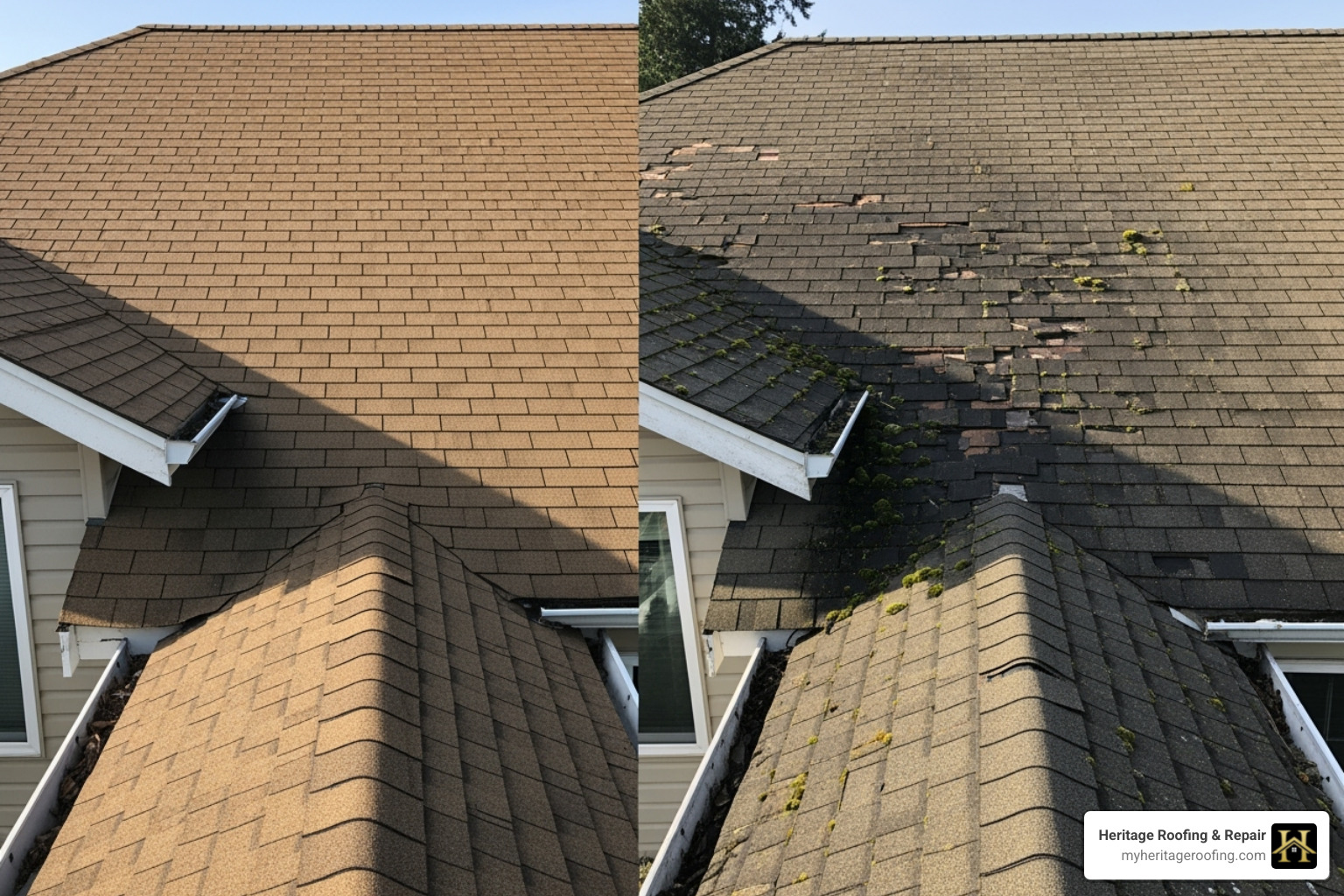
What Should You Do if Your Roof Insurance Claim is Denied?
A denial isn’t the end of the road. Statistics show that about 40% of appealed roof damage claims result in increased settlements.
- Review the Denial Letter: Understand the specific reason for the denial.
- Follow the Appeal Process: Most insurers have an internal appeal process. Follow their instructions precisely.
- Request a Second Opinion: You can ask for another adjuster to re-evaluate the claim or hire a public adjuster who works for you.
- Provide New Evidence: Submit any additional documentation, photos, or a more detailed report from your roofing contractor.
Will Filing a Claim Increase Your Insurance Premiums?
Filing a roof insurance claim can impact your premiums, but it’s not guaranteed. Insurers look at claim frequency and severity. Filing multiple claims in a short period is a red flag. However, claims related to widespread natural disasters may have less of an individual impact.
Our Advice: For minor repairs close to your deductible amount, it’s often better to pay out-of-pocket. For significant damage, however, that’s what insurance is for. Don’t hesitate to file a legitimate claim.
Frequently Asked Questions about Roof Insurance Claims
We get a lot of questions about the claims process. Here are some of the most common ones we encounter:
How long does the roof insurance claim process usually take?
The timeline for a roof insurance claim varies. Generally, you can expect an adjuster’s inspection within a week or two of filing. After the inspection, an approval or denial decision usually takes another week or two. Once approved, receiving the reimbursement check can take 30 to 60 days. The entire process, from filing to payment, often takes between one and three months.
What are the best roofing materials for insurance purposes?
Insurers favor durable, resilient materials because they reduce the likelihood of future claims. Choosing these materials can sometimes lead to lower premiums.
- Metal Roofing: Highly durable, metal is resistant to harsh weather, fire, and corrosion. Its longevity and performance often lead to lower home insurance costs.
- Impact-Resistant Asphalt Shingles (Class 4): These shingles are specifically designed to withstand hail and debris better than standard shingles. They offer a great balance of cost and protection and may qualify for insurance discounts.
- Tile Roofing (Clay or Concrete): Known for longevity and fire resistance, tile is a durable option that performs well in extreme weather.
Investing in a more resilient roof is a smart long-term strategy that can save you money and hassle.
What is Ordinance and Law coverage and do I need it?
Ordinance and Law coverage is an essential but often overlooked policy add-on. It covers the extra costs required to bring your home up to current building codes during a repair or replacement.
Building codes are constantly updated for safety and resilience. If your roof is damaged, local authorities will likely require the new work to meet the latest codes. Your standard policy may only cover rebuilding to the original standard, leaving you to pay for mandatory upgrades out-of-pocket.
This coverage protects you from unforeseen expenses related to code compliance. Given the evolving nature of building codes, especially in areas with severe weather, this coverage provides crucial peace of mind.
Conclusion: Protecting Your Investment for the Long Haul
A roof insurance claim is a process that requires diligence, documentation, and a clear understanding of your policy. By taking a proactive approach—inspecting for damage, documenting everything, and partnering with a trusted professional—you can steer the experience successfully. Protecting your home is a continuous effort, and ensuring your roof is sound is the first line of defense against the elements. If you’ve experienced storm damage and need expert guidance through the insurance and repair process, the team at Heritage Roofing & Repair is here to help.
We offer free inspections and comprehensive insurance claim assistance, ensuring you get the support you need every step of the way. Don’t let the complexities of insurance hold you back from getting the roof repairs you deserve.
